If you have a website, getting traffic is vital for your success. But this success doesn’t come from only web browsers and desktop computers. Why? That’s because people use their phones more than their computers within a day. This makes mobile phones a critical point for website owners. For this reason, these people constitute a significant majority of the traffic coming to websites. When considering all these things, we must emphasize the importance of website owners prioritizing mobile devices. This is where SEO for mobile search, or mobile SEO, comes into play. We will introduce everything you should know about this term in today’s mobile SEO guide. Let’s start with its definition and move to mobile SEO best practices.
What Exactly Is SEO?
SEO refers to search engine optimization. It is also defined as the skill of ranking higher in search engine results on the web without paying any money. In SEO, you optimize your content based on search engines to attract more internet users’ attention and drive more traffic to your website. Also, SEO tools play an important role in all of this.
What Is Mobile SEO?
Google Mobile SEO or mobile search SEO can be described as a process of optimizing a website for search engines. So, the question is, “Why?” The answer lies in the nature of SEO for mobile sites. When you optimize your web pages for mobile devices, from smartphones to tablets, those web pages will get more organic traffic. More organic traffic means higher rankings on Google, Yahoo!, Bing, and others. So, what do we mean by “What is optimizing a website for mobile devices?” It’s simple to understand.
Mobile SEO includes optimizing the site’s content, design, and technical parts. Check your website’s SEO with SEO analyzer to learn more. So that website will perform well on smaller screens, such as mobile phones or tablets. This process consists of a wide range of elements, such as;
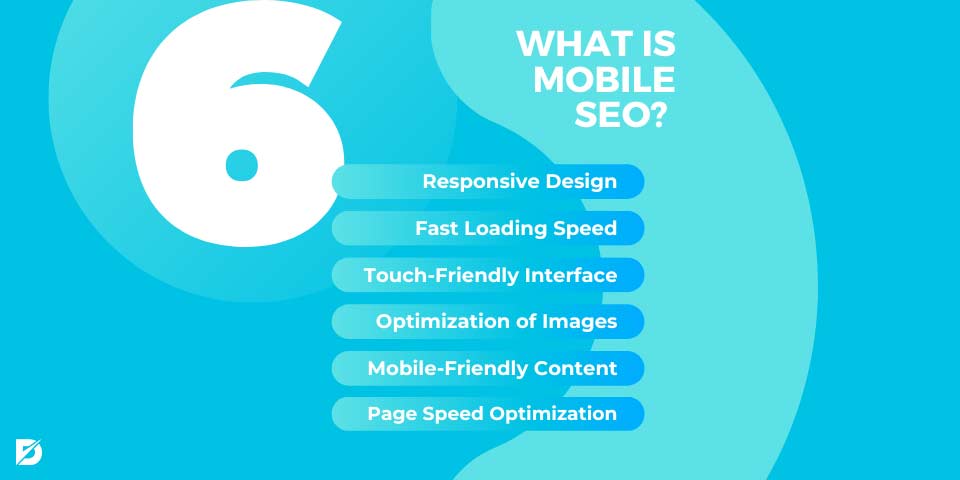
- Responsive Design: Creating a flexible design that fits different screen sizes perfectly. So the website looks the same and works well on computers and mobile phones.
- Fast Loading Speed: Ensuring a website opens quickly when a user clicks on it in search results. This prevents user frustration and increases that’s website search engine rankings.
- Touch-Friendly Interface: Using includes buttons, links, and menus that allow users to tap with their fingers easily. This small but effective design lets users avoid small elements that are difficult to interact with.
- Optimization of Images and Other Media Types: compressing images and other media types and turning them into efficient formats. This enables users to view high-quality content while reducing load times.
- Mobile-Friendly Content: Adapting the website’s content for mobile consumption using easy-to-read text, appropriately sized images, and touch-friendly navigation elements.
- Page Speed Optimization: Optimizing the website’s code and server performance in order to improve page load times on mobile phones and tablets.
Why Is Google More Important For Mobile SEO Than Other Search Engines?
Google is indeed your priority when it comes to mobile SEO. There are a lot of reasons behind this argument. The first reason is that Google holds the largest market share in the search engine industry. So, there is still a significant gap between it and its closest competitor as it has dominated the market. The second reason is that this world’s most popular search engine has shifted to a mobile-first indexing approach. What do we mean by this? Google now primarily uses the mobile version of a website’s content for indexing and ranking. That’s because it places great importance on user satisfaction and the best experience. Besides, Google frequently updates its algorithm in order to create a better user experience. At this point, many search updates focus on mobile friendliness and mobile usability in your mobile SEO strategies.
Moreover, Google has started using mobile-friendly labels, displaying these labels in its search results. These labels indicate to internet users whether a website is optimized for smartphones or tablets. Once users know that, they make click decisions without visiting the website. This also directly affects the organic clicks of that website positively or negatively.
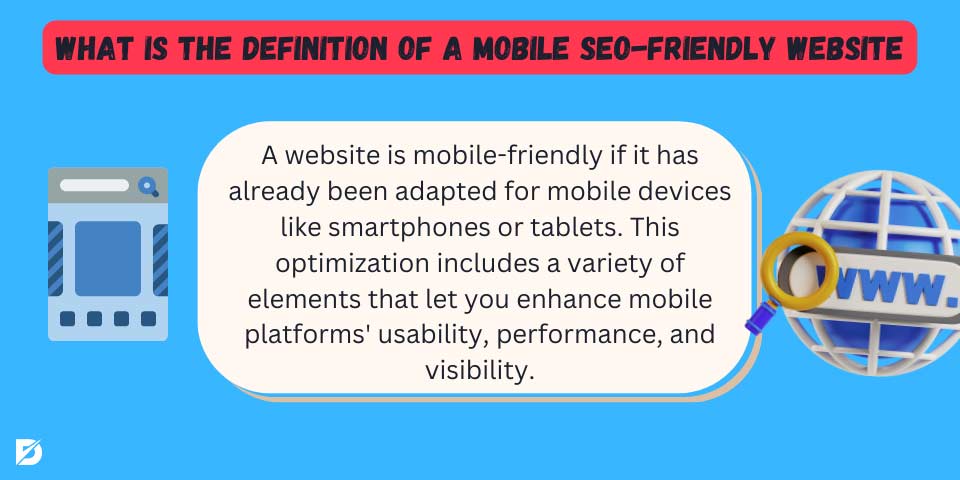
What Is the Definition of a Mobile SEO-Friendly Website
Especially when we consider the increasing use of mobile devices for internet browsers, a new terminology comes to our lives: Mobile-friendliness. This term is essential to Google and other search engines’ algorithms. What does it mean?
Let’s say a website is a mobile-friendly website, meaning that it has already been optimized for smartphones or tablets. This optimization encompasses different factors that allow you to improve usability, performance, and visibility on mobile platforms. As we briefly mentioned above, there are essential elements of a mobile SEO-friendly website. Some of them are responsive design, fast and quick loading times, optimized images and media, mobile-friendly content, and a touch-friendly interface. All these come together and create a mobile-friendly experience.
Search engines receive an indication that demonstrates a smooth and user-friendly experience on smaller screens. So, that website will have higher rankings on search engine results pages (SERPs).
Why Is Mobile SEO Important?
Once we understand mobile SEO, we should also answer the “Why is mobile SEO important?” question. We have a lot of things to list. However, we found it appropriate to touch upon the most important ones to avoid overwhelming you. At this point, what’s important is knowing the principles of SEO.
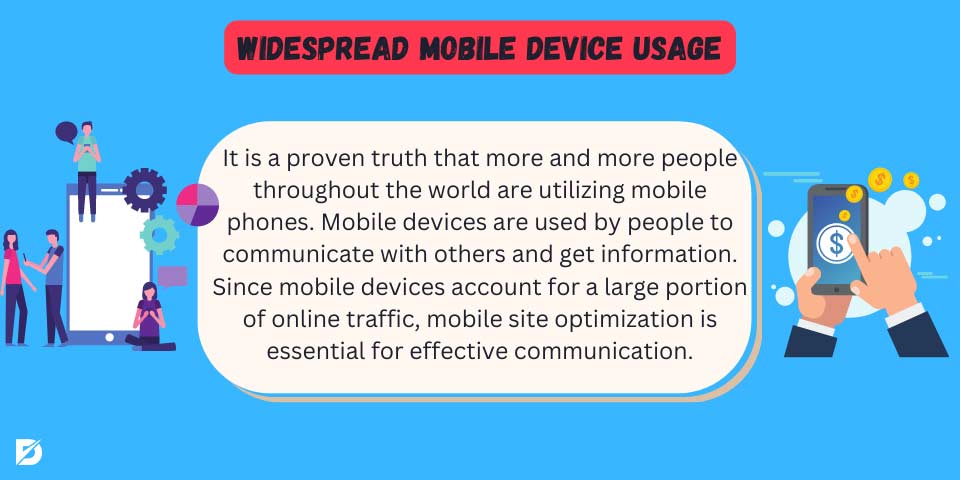
Widespread Mobile Device Usage
There is a fact that the use of mobile phones has been increasing one by one across the world. People use their mobile devices to access information and connect with others. With much online traffic from mobile devices, optimizing your site for mobile is crucial to connecting effectively.
Google’s Algorithms About Mobile Friendliness
Search engines, and especially Google, recognize the significance of mobile-friendly websites. Google’s algorithms take mobile-friendliness into account when determining search rankings. This makes it an essential factor in the mobile SEO world. Websites that fail to meet the mobile optimization SEO standards can be pushed down the search results pages. This means these websites are ranked lower in search engine result pages, so they lose visibility and traffic to competitors.
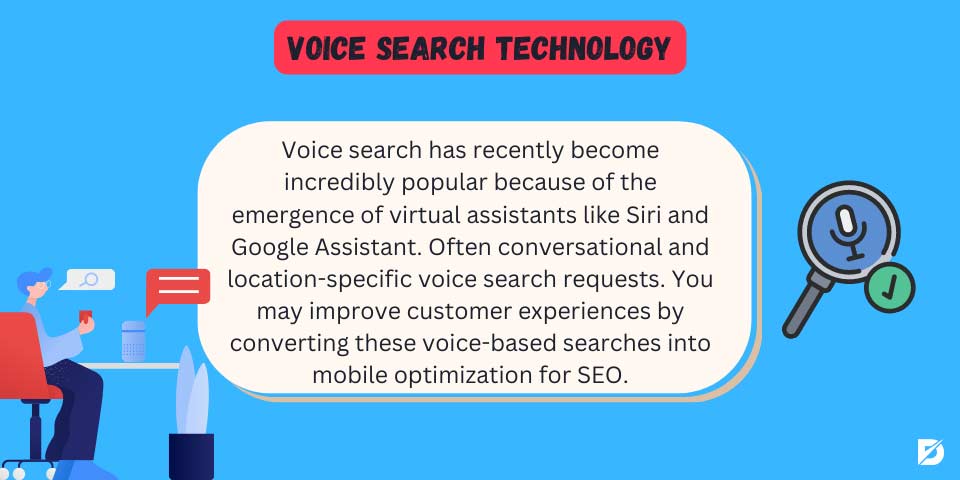
Voice Search Technology
With the rise of virtual assistants like Siri and Google Assistant, voice search has recently gained incredible popularity. Voice search queries are often conversational and location-specific. Mobile optimization in SEO helps you turn these voice-based searches into better customer experiences.
Competitive Advantage
Due to the incredible usage of mobile devices, SEO mobile optimization has become standard practice. Therefore, making a website mobile-friendly is a must. If you don’t have a mobile-optimized site, your competitors get ahead by taking multiple steps. You lose the visitors you could convert into actual customers to your competitors who offer them a more mobile-optimized opportunity.
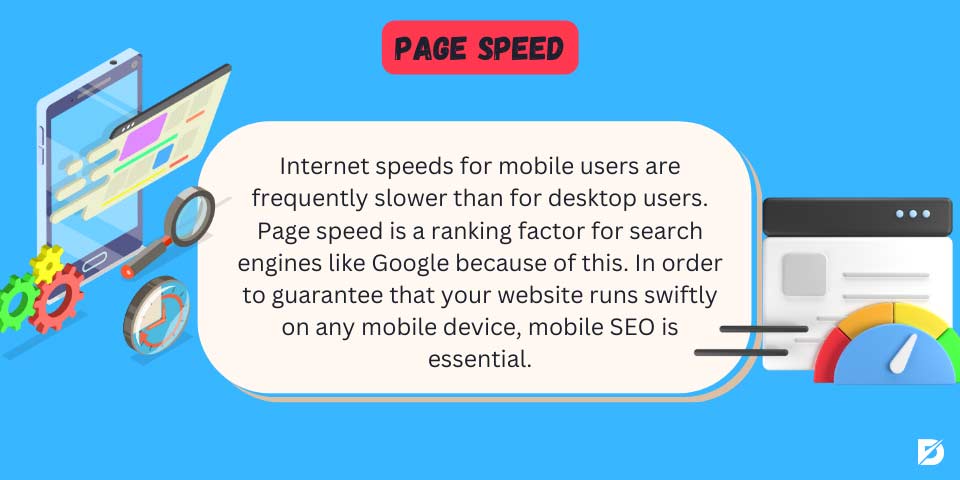
Page Speed
Mobile users often have slower internet connections compared to desktop users. That’s why Google and other search engines consider page speed a ranking factor. So, mobile SEO is critical in ensuring your website loads quickly on any mobile device. Slow-loading pages can lead to higher bounce rates so that you will have lower search rankings.
User Experience (UX)
Mobile users have different needs and behaviors than desktop users for several reasons, such as smaller screens. Mobile-friendly websites provide a better user experience by adapting to smaller screens, touch navigation, and faster loading times. A positive user experience creates lower bounce rates and higher chances of conversions.
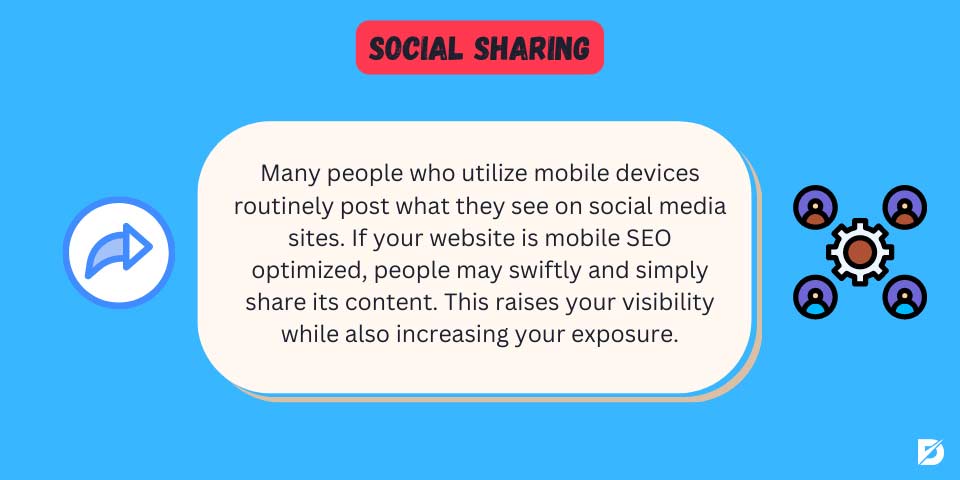
Social Sharing
Many mobile device users frequently share what they find on social media platforms. If your website is optimized for mobile SEO, users easily and quickly share your website’s content. This not only increases your exposure but also improves visibility. Besides, you will have a chance to get more backlinks.
Local Searches
Mobile searches can also be related to local businesses and services. Therefore, users often use their mobile devices to find information about nearby businesses, like store locations, reviews, and contact information. Once you optimize your website for mobile local SEO, you can connect with potential customers looking for businesses in their area.
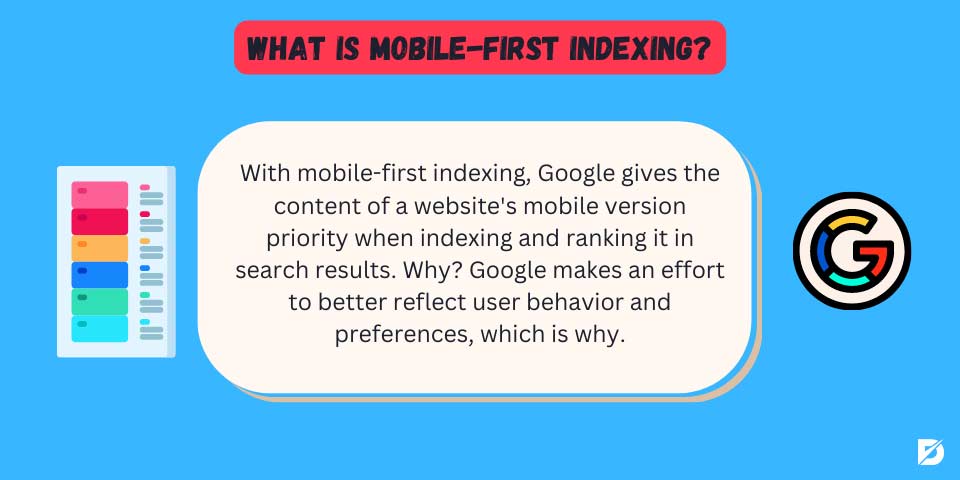
What Is Mobile-First Indexing?
As we mentioned above, mobile-first indexing plays a vital role for Google. So, what do we mean by this term? Let us briefly explain it.
When we check traditional indexing and ranking, Google and others consider the desktop version of a website’s content. This was the same case even when a user searched on a mobile device. However, this traditional approach is ending when it comes to mobile-first indexing. Mobile-first indexing means Google prioritizes the mobile version of a website’s content for indexing and rankings in Google search results. Why? That’s because Google tries to reflect user behavior and preferences better.
Things You Should Know About Mobile First Indexing
Understanding mobile-first indexing is essential for anyone who works on search engine optimization mobile vise. Now, you know a few key things, and they might affect how easily users find your website on Google. So you can see that making your website and web pages mobile-friendly is not too hard to achieve. We would like to look at four crucial things about mobile-first indexing. In the end, you can get help to look for problems on your website and fix any issues you might have. Here’s the mobile SEO checklist.
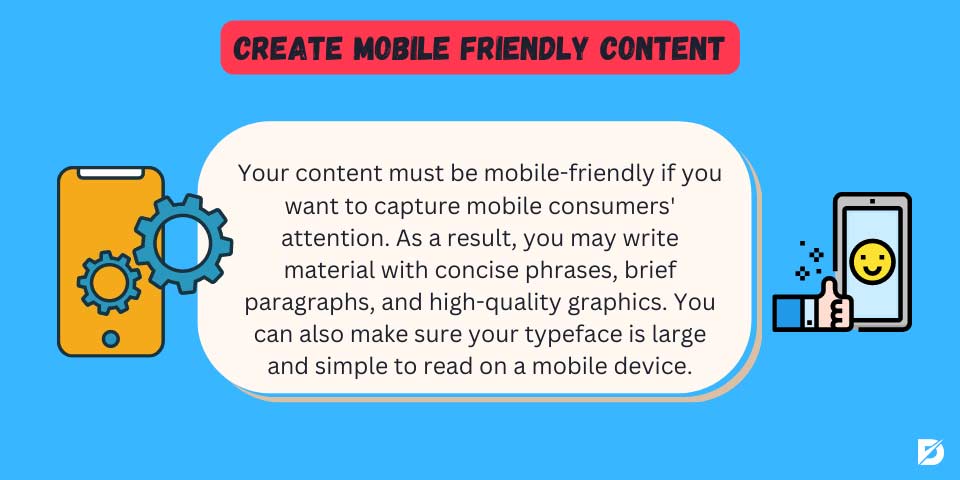
Create Mobile Friendly Content
As you can easily guess, reading from a screen isn’t easy. It’s even trickier on a mobile device than on a big screen. If you want to attract the attention of mobile users, your content needs to be mobile-friendly. That means you can create your content using short sentences, small paragraphs, and high-quality images. You can also ensure your font size is big and easily read on mobile. Learn how to check if a website is mobile-friendly and create mobile friendly SEO content.
Do A Mobile Friendliness Test
A mobile friendliness test lets you understand how well your website and web pages are optimized for mobile devices. To conduct this test, you have a lot of options. You can now use Google’s Mobile Friendly test to quickly examine your website’s mobile version. At the end of the day, you can quickly and quickly gain insights into its mobile usability. These tools check a wide range of factors, such as responsive design, touch-friendly elements, and loading speed.
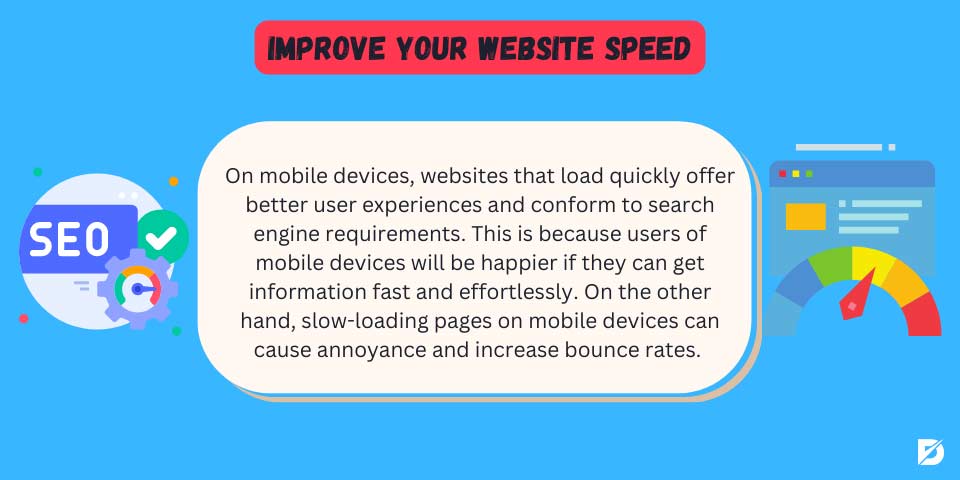
Improve Your Website Speed
Fast-loading websites on mobile devices provide a better user experience and align with search engine preferences. That’s because mobile users will be more satisfied when they quickly and easily access information. Conversely, slow-loading pages on mobile devices can lead to frustration and higher bounce rates. To speed up your websites, you can optimize the images, remove unnecessary codes, and reduce redirects.
Create a Responsive Web Design
Once you create a responsive design, you can ensure your site looks and works well on all devices, especially mobile phones. Here, you can use flexible layouts that adjust smoothly to different screen sizes. Besides, you can use images that perfectly fit various devices. So you can ensure that web pages look great on large and small screens. At this point, we really suggest you avoid using pop-ups that could annoy users. Instead, you should use an easy-to-use scroll-and-tap interface.

How Does Mobile-First Indexing Work?
Thanks to mobile-first indexing, Google’s algorithm first crawls and indexes the mobile version of a website’s pages. This means the mobile version of a website’s pages becomes the primary source for determining its relevance and ranking in SERPs. Here’s how mobile-first indexing generally works.
- Crawling: Google’s bots visit your website and each page in order to understand your content. With Mobile-first indexing, these bots start by looking at the mobile version of a site. They check how the site appears on mobile phones and tablets and what information it contains.
- Indexing: Once Google’s bots check the mobile version of your website, it includes this information in its index. The index is like a vast database that stores details about your website. So they can understand what the site is about and when to show it in SERPs.
- Ranking: When an internet user searches for something online, Google uses its index to find the most relevant websites. It looks at factors like content, keywords, and mobile-friendliness. Websites that work well on mobile devices get a better chance of appearing higher in the search results.
Key Elements for a Mobile-Friendly Website
Up to now, we have covered the basics of mobile SEO. Now, it is time to check the critical elements of a mobile-friendly website. When creating a mobile-friendly website, there are many essential elements you need to consider. However, we can say that precisely three elements play a crucial role in ensuring your success. Responsive design, dynamic serving, and separate URLs are critical factors. These elements give users a perfect experience on different devices and screen sizes. Now, we would like to look at these three elements one by one.

Responsive Design
Responsive design aims to create websites that offer an optimal and seamless viewing experience across various devices and screen sizes. So, its goal is to ensure websites adapt effortlessly to different devices and screen dimensions. In order to create a responsive design for your website, there are some adjustments you should make. In the end, you can increase the functionality of your website on different devices, from desktop computers to smartphones. Here are some sub-elements of responsive design you can check.
- Website Usability: The usability of a website allows you to simplify navigation, ensure readable content, and use touch-friendly elements on mobile devices. You can create seamless and engaging user interaction once you prioritize usability within the responsive design.
- Page Load Time: With efficient coding, adaptive content, and a mobile-first approach, you can create faster load times. This becomes a smoother experience for mobile users at the end of the day. These practices not only reduce bounce rates but also contribute to improved SEO rankings by providing a user-friendly browsing experience.
- Flexible Images and Media: Once you adapt your visual content to various screen sizes and resolutions, the responsive design lets you create a consistent user experience. Optimizing images for speed and employing responsive video embeds let you reduce bounce rates and improve SEO performance.
- Breakpoints: Once you define specific screen widths where layout and design adjustments occur, breakpoints let you ensure an optimized user experience. These are achieved by preventing content distortion and enhancing readability.
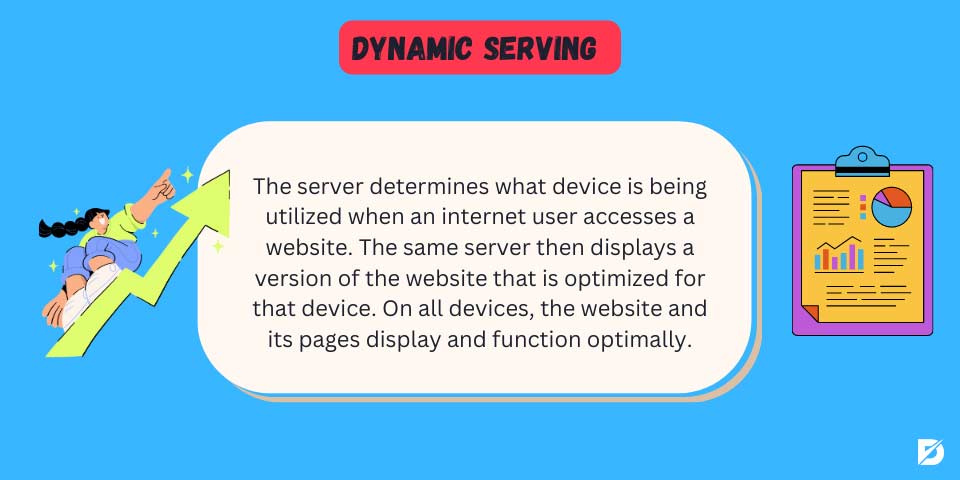
Dynamic Serving
Dynamic serving can be briefly described as a method in web design that plays an essential part in mobile devices. How does it work? When an internet user visits a website, the server determines what device is being used. After that, the same server shows a version of the website that works perfectly on that device. The website and its pages look and work best on all devices. To understand this terminology better, let us compare responsive design and dynamic serving.
In responsive design, a single design fits/adapts to different types of screen sizes. It’s like making a website that can automatically adjust its layout and content to fit different screen sizes. On the other side, dynamic serving involves maintaining different sets of HTML and CSS for different devices. So you can create a more optimized user experience based on the device’s capabilities while still using a single URL.
Let’s say you have a website that provides recent news articles. When internet users access your website from a desktop computer, they see a layout optimized for larger screens. However, when someone accesses the same website from a mobile phone, dynamic serving comes into play. The server detects that the user is on a small-screen device and serves a different website version. This version might have a single-column layout, larger text for easier reading, and fewer images to ensure faster loading times. So, the user gets a version of the website specifically designed to work well on their smartphone.
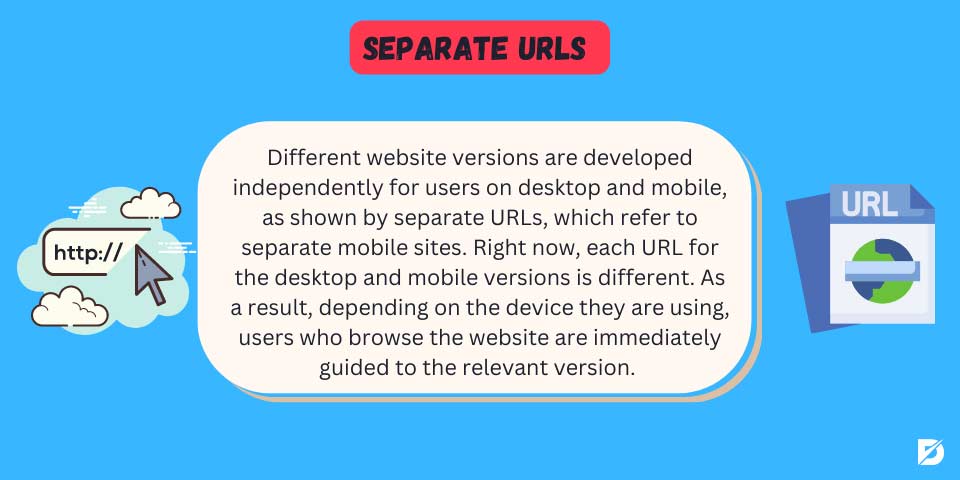
Separate URLs
Separate URLs refer to separate mobile sites where different website versions are created separately for desktop and mobile users. At this point, each desktop and mobile version has its distinct URL. So when users access the website, they are automatically redirected to the appropriate version based on the device they use. This means you’ll have one address for people using computers, like “https://www.yoursite.com/,” and a different one for mobile devices. The mobile address might start with “m” or include the word “mobile,” like https://m.yoursite.com/. These separate versions often have different layouts, designs, and content structures optimized for the relevant devices. Learn how to optimize title, description, and URL for SEO here.
Of course, this vital element can provide adjusted experiences for different devices. However, as a website owner, you need to maintain and update two separate versions of web pages. So this might be complex and effortless and time-consuming. Besides, there might be some problems in the eyes of Google and other search engines. That’s because they need to understand the relationship between the two versions to avoid duplicate content issues. Don’t forget to use a duplicate content checker. This might make it unclear for Google to determine which page should be ranked correctly in its SERPs.
How to Check If Your Website Is Optimized for Mobile Devices?
Let’s say you create the mobile version of your website or optimize your web pages for mobile devices. Now, it’s time to evaluate your website’s user-friendliness. At this point, there are a lot of tools you can choose from. While some are entirely free, others might require a small fee. Of course, there’s something even more important than this: Reliability and accuracy. At this stage, you need to choose something that provides reliable and accurate results. Don’t worry. We will talk about three tools that are favorites of Google, which are free for your website. You can also check the free SEO tools to use for your development.
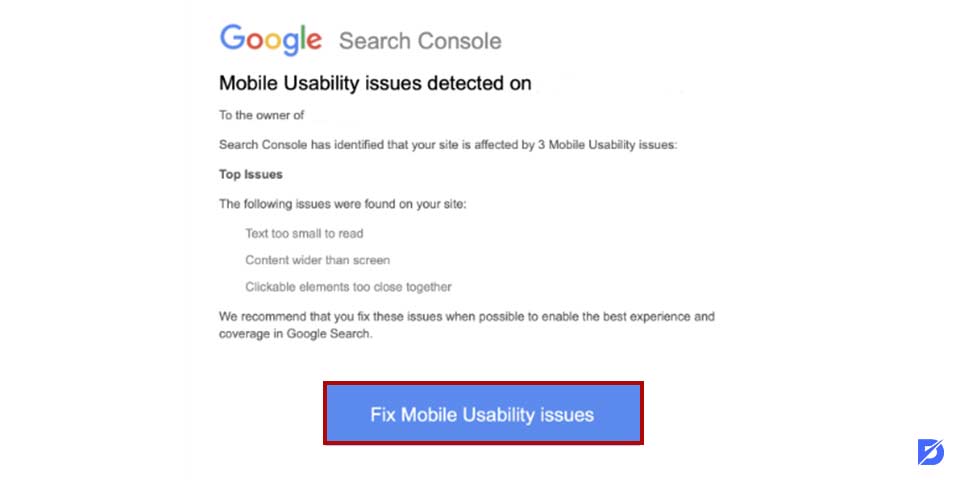
Google Search Console
Google Search Console is one of the essential tools that lets website owners monitor and manage their websites. These great tools help you understand how Google interacts with your website. The insight can be about indexing status, search performance, or issues that might have a negative impact on your rankings. One of the great features of Search Console is its quick and easy mobile optimization checking SEO for mobile devices. However, you might be new to mobile SEO or unsure how to use this effective tool. Don’t worry; we are happy to provide all these steps you need to use the Search Console.
- Log into your Google Search Accounts. If you don’t have one, you can easily create a new one by verifying ownership of your website.
- Choose the property from your Search Console dashboard after opening your account. This is the website you want to check if it is optimized for mobile devices.
- When you look at the left side menu, you will see the Mobile Usability option. On the new page, you will see a report that displays if there are any issues related to mobile devices. For example, you might see an error of “Test too small to read” or “Clickable elements too close together.”
- If you click on a specific issue, you will get more details and see examples of affected web pages on your site. Here, the Search Console will offer points about how to fix these detected issues.
- Once you see any issues, you can make adjustments to increase the mobile-friendliness score of your website.
- After making changes to your website, you can click the “Validate Fix” button. This will let Google recheck the specific issues and verify if it’s been resolved.
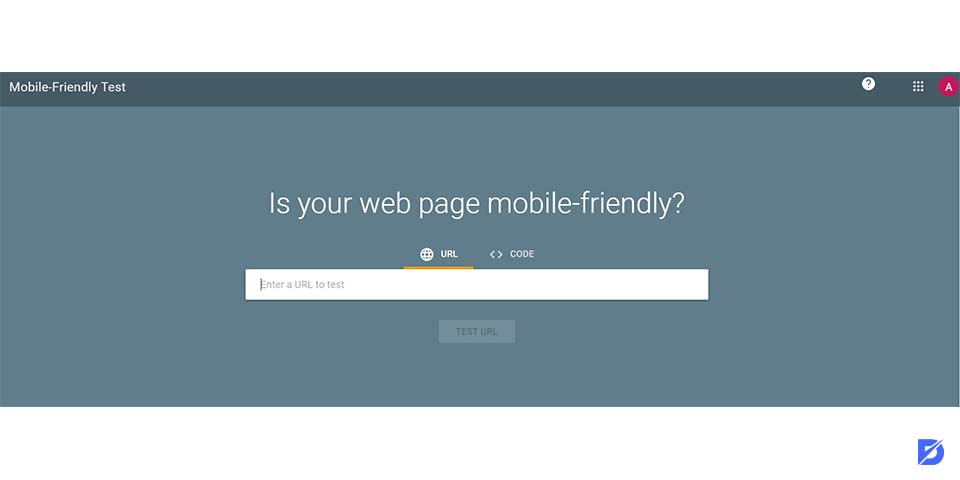
Mobile-Friendly Test Tool
Another good way to understand whether your websites are optimized for mobile devices is to use Google’s Mobile-Friendly Test tool. This web-based application lets you quickly understand whether individual pages on your website are optimized for mobile devices. You can also understand how web pages look on different screens and if it works when you turn the device sideways. So, how are you going to use a mobile-friendly test tool? Here are the world’s most straightforward steps to use Google’s mobile-friendly tool.
- Open your preferred web browser and search for “Google Mobile-Friendly Test. Or, you can simply click on https://search.google.com/test/mobile-friendly.
- On this web page, you will see a simple-designed text box. Type or paste the webpage URL you would like to test for mobile-friendliness. It’s important to note that you don’t have to enter only the homepage URL; you can enter any particular page of your website.
- Once you enter the URL into the corresponding box, click the orange Test URL button.
- The tool will process the webpage and provide a report. Then, you will simply see whether the page is mobile-friendly or not. You will see, “This page is easy to use on a mobile device if it’s mobile-friendly.” However, if it’s not, the tool will offer feedback on what you need to do for improvement.
- If you want to know more about a problem, move your mouse over it and click the question mark. These problems can be “Clickable elements too close together,” “Text too small to read,” or “Viewport not set.”

PageSpeed Insights
As mentioned above, users’ experiences on a website are one of the key elements to ranking higher on Google. Here, how fast your website’s pages load is fundamental in this regard. The tool evaluates both the desktop and mobile versions of the webpage. Besides, it offers suggestions for improvements to enhance its loading speed.
PageSpeed Insights takes into account different factors that can influence your webpage’s performance, like server response times and code efficiency. According to PageSpeed, a score of 90 or above is good and indicates that your website is well-optimized for speed. So, you should aim for a loading time of under 3 seconds. So, the question is, “How can you use PageSpeed Insights to understand whether your web pages provide a good user experience.” Here are the basic steps to use this great tool.
- Open your preferred web browser and search for “Google PageSpeed Insights.” Or, you simply click on https://developers.google.com/speed/pagespeed/insights/
- You will see a text box on the new page. Type or paste the page URL you want to test for performance.
- Once you paste the URL, click the blue Analyze button to see the results.
- The tool will analyze your page and provide performance scores for desktop and mobile versions separately. On the same page, you will also be able to see suggestions for improvements to improve the loading speed. These suggestions can include compressing images, leveraging browser caching, or optimizing code. You can also see more details by clicking on each suggestion and how to implement the recommended changes.
- Once you implement changes, you can re-analyze the web page by entering its URL again. So you will be able to see how your adjustments have impacted the performance score.

Dopinger Mobile-Friendly Test Tool
Dopinger.com is a digital marketing agency which is providing the best possible solutions in search engine optimization (SEO). With its SEO experts and digital marketing experts, Dopinger has been serving its users since 2019. They aim to help different types of companies rank higher on their website in browsers with the help of SEO experts. For the last four years, they have implemented different types of projects from 20 countries. On their website, there is an ‘’SEO’’ section where they allow developers to enter their website URLs and help them get free offers in order to increase their website’s visibility. They help their customers to rank their websites in every aspect.
As you can see from the title, Dopinger also has a section on its website called ‘’Mobile-Friendly Test’’. Mobile-Friendly Test is the type of test that decides if your website is mobile-friendly or not. This test basically helps the developers of their websites to figure out what they are going to work on according to the feedback they get from the test. Just like in the previous section, developers of certain websites enter their website URLs to check on their website and get feedback if their websites have errors or mistakes. The purpose of this section is simply to help these users improve their websites by fixing the mistakes of their websites. Dopinger’s mobile-friendly testers are helping these users to inform about optimization. That way, these users who have their own websites are going to be able to provide a better service for their mobile users.
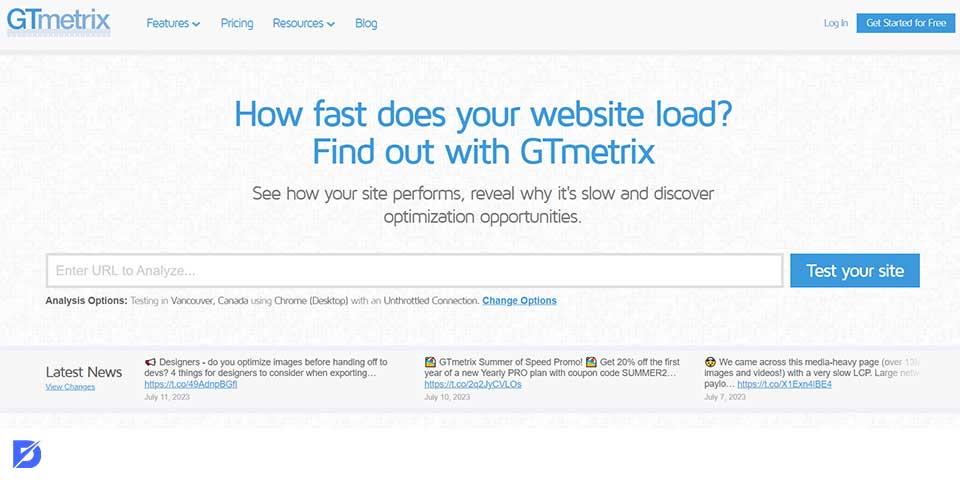
GTmetrix
GTmetrix is a web-based tool that provides information about how a website performs by checking page speed and optimization. Even if GTmetrix is not for mobile SEO, GTmetrix can provide assistance for mobile SEO. The reason is that page speed and optimization are essential things if you want to rank your website in mobile search results. When you rank up your website successfully, your mobile users’ experience will also increase to the point they will trust your mobile website’s quality. However, that is not the only way you can use GTmetrix for your benefit.
Let’s look at how you can use GTmetrix in other ways:
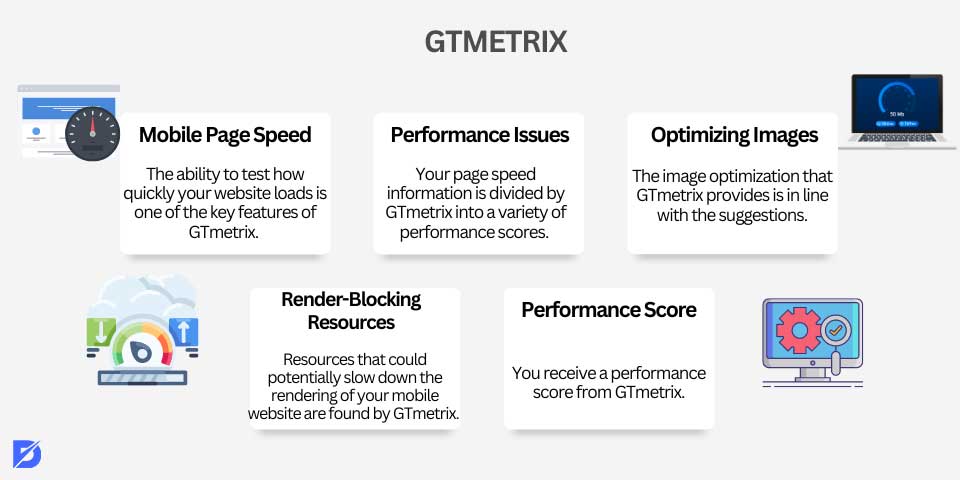
- Mobile Page Speed: One of the important features of GTmetrix is being able to test the loading speed of your website. There is a section where you can enter your URL into GTmetrix, and it will give you feedback about the loading speed of your mobile page, just like how it works when you use Dopinger.
- Performance Issues: GTmetrix divides your page speed data into a number of performance scores. This will not only help you get detailed information about your website statistics but also help you determine the actual performance issues.
- Optimizing Images: Probably one of the most essential features GTmetrix offers you is the optimization of images related to the recommendations. This will help your website for mobile users to download images quickly.
- Render-Blocking Resources: GTmetrix detects resources that have a chance to slow down your mobile page rendering. If you do not optimize the resources in your website, your mobile website page will download slower than the average loading page speed.
- Performance Score: Depending on your website’s performance, GTmetrix calculates your performance score. If your website has a higher performance score, your mobile page will rank up in search results.
Mobile Security and HTTPS
In terms of mobile SEO, both Mobile security and HTTPS are extremely important two things in the process of website development. Here’s why these two are essential for mobile SEO:
Ranking
From Google’s perspective, HTTPS is a ranking material, meaning that Google prioritizes HTTPS websites. Websites that support HTTPS are the ones that easily rank up; as a result, both desktop and mobile users can see it in search results.
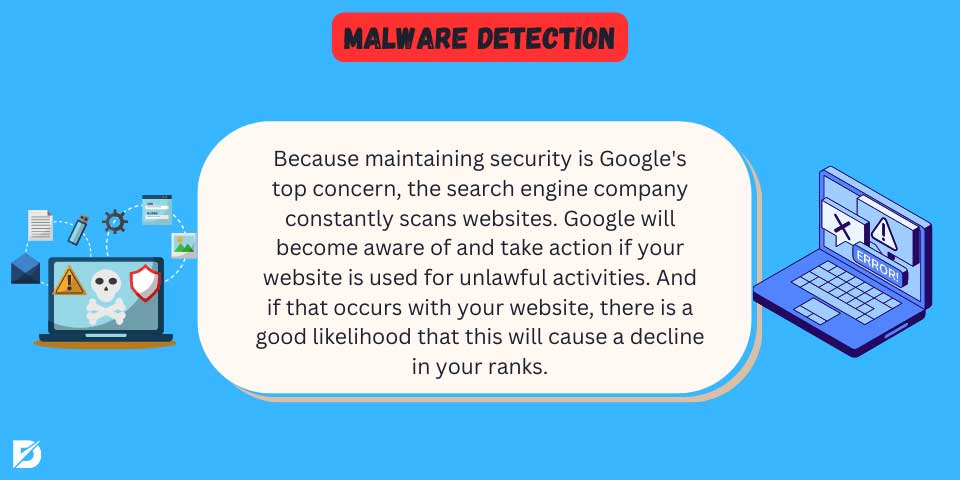
Malware Detection
Ensuring security is the top priority for Google, so Google always checks on websites. If your website is become a part of illegal purposes, Google will realize it and take precautions. If that happens to your website, your rankings have a high chance of dropping due to this reason. So check the website malware scan options.
So, if you want your website in the top priority, you must get an SSL (Secure Sockets Layer) certificate. After that, make sure you adjust your SSL to work properly for both the desktop and mobile interface of your website.
What Are the Differences Between Mobile and Desktop SEO?
The distinctions between mobile SEO and desktop SEO come from the optimization strategies required to meet different user behaviors. We would like to move on step by step to clarify the subject.
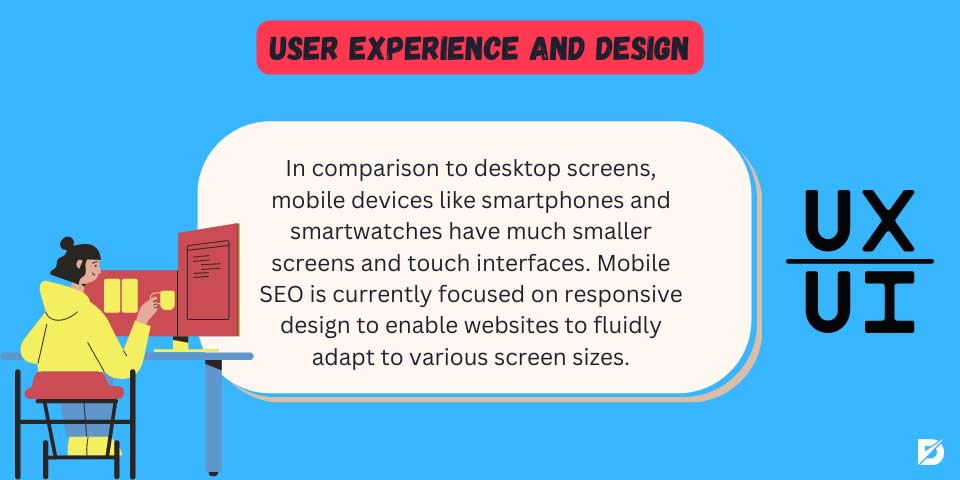
User Experience and Design
Mobile devices like smartphones or smartwatches have significantly smaller screens compared to desktop screens, and they have touch interfaces. At this point, mobile SEO concentrates on responsive design so that websites can seamlessly adapt to different screen sizes. It also focuses on touch-friendly navigation and fast loading speeds to increase user experiences. On the other side, desktops have more screen space to display content. Therefore, desktop SEO focuses on layouts that are okay with larger screens. This allows desktop users to quickly and fastly view and read the content.
Page Speed
Page speed plays a vital role on mobile devices where users expect fast and quick access to information. Therefore, website owners need to optimize images, minimize codes, and predict and leverage browser caching. All these help them to reduce the waiting time of users. At the end of the day, the website reduces the bounce and abandonment rate by increasing user satisfaction. On the other side, okay, the loading time is also essential for desktop SEO. However, desktop page speed may be more forgiving because users can look for another thing in a new tab.

Local SEO
Mobile devices, especially smartphones, are frequently used for local searches. Therefore, we generally adopt our website for “near me” queries. As business owners on the web, we need to optimize our mobile site by providing accurate business information and local keywords. On the other side, okay local SEO is again important for desktop SEO, but the importance level is reduced. That’s because desktop users tend to seek broader information. Another reason is that carrying and using a laptop while driving is much more complex than a phone. Therefore, the information searched for on a computer and a smartphone will be different.
Voice Search
When we hear the voice search term, we first think of mobile devices rather than computers, right? The primary reason is that voice search is less common on desktop devices. Therefore, optimizing your website for desktop SEO is not a must. However, voice search is closely tied to mobile devices. It needs to focus on understanding natural language queries and long sentences.
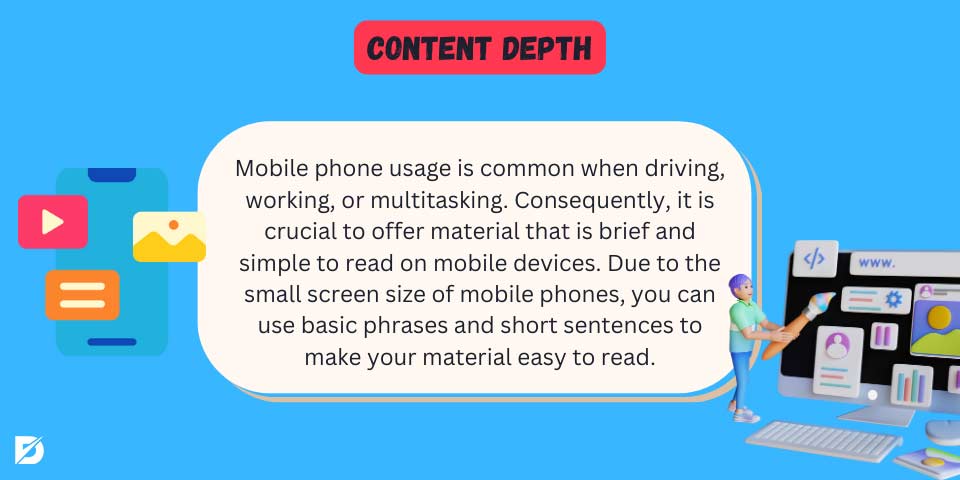
Content Depth
People use their mobile phones while driving, cooking, or multitasking. Therefore, it is essential to provide content that is concise and easy to read on mobile devices. To make your content easy to read, you can use simple words with short sentences due to limited screen space on mobile phones. On the other side, you can focus on more in-depth content on desktops as people have larger screens to view the content. You can create and share longer articles and more comprehensive resources for your website’s desktop version. That’s because desktop users have broader search intents as they seek more detailed information.
Mobile SEO Tips
As search engines prioritize mobile-friendly content and user experience, it’s essential to be careful about some points in mobile SEO. That’s why you might be looking for valuable tips to improve your website’s mobile friendliness. In the end, you have a chance to make sure that your website will rank well in mobile search engine optimization results. Don’t forget to use a rank tracker. Of course, once you are ranked higher in SERPs, you will be able to drive more significant organic traffic and engagement. However, neglected mobile SEO might lead to reduced visibility, higher bounce rates, and missed opportunities to connect with visitors. Therefore, understanding and implementing practical and efficient mobile SEO analysis and tips are critical for achieving online competitiveness. Now, we would like to look at the most beneficial mobile SEO tips you can use.
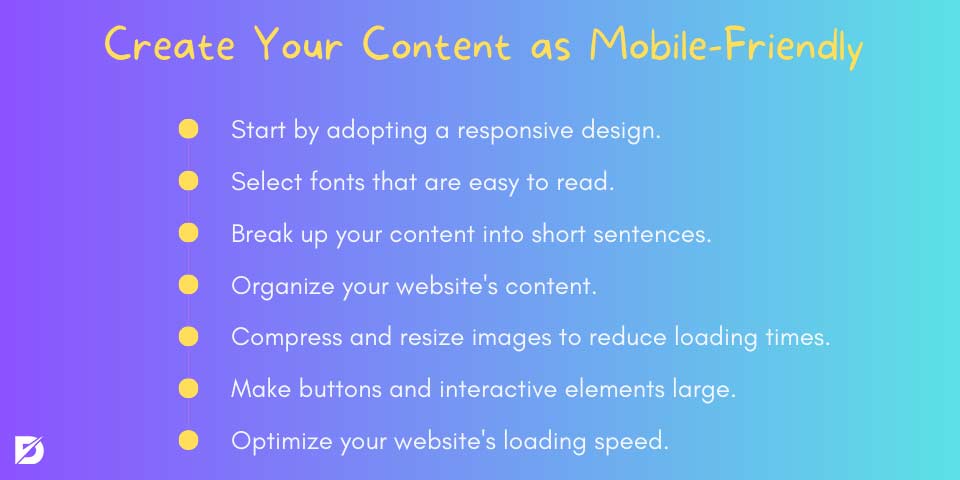
Create Your Content as Mobile-Friendly
Creating mobile-friendly content is one of the most fundamental steps to successful mobile SEO. Since mobile devices, especially mobile phones, continue to dominate the internet world, it’s essential to make your content accessible and engaging. So your content smoothly runs on smaller screens. You might be wondering about how to make your content SEO mobile friendly. To achieve this, there are some critical elements.
- Start by adopting a responsive design. So, your content automatically and perfectly adjusts your content layout to fit different screen sizes. As a result, your content and web pages look good on all devices.
- Select fonts that are easy to read on small mobile screens, and the font size should be comfortable for mobile users. You can achieve it by selecting a font that lets people easily view the content without zooming in.
- Break up your content into short sentences and paragraphs so users can easily view and read your content on small mobile screens.
- Organize your website’s content with descriptive and informative subheadings. This enables people to easily and quickly find the information they seek.
- Compress and resize images to reduce loading times without reducing the quality. To do this, you need to use the appropriate image formats and provide alt text for images.
- Make sure that buttons and interactive elements are large enough and spaced well to accommodate touch gestures perfectly. You should also avoid placing elements too close together to prevent unwanted clicks.
- Optimize your website’s loading speed by reducing server response time or minimizing codes. You can use PageSpeed Insights provided by Google to detect the areas for improvement.
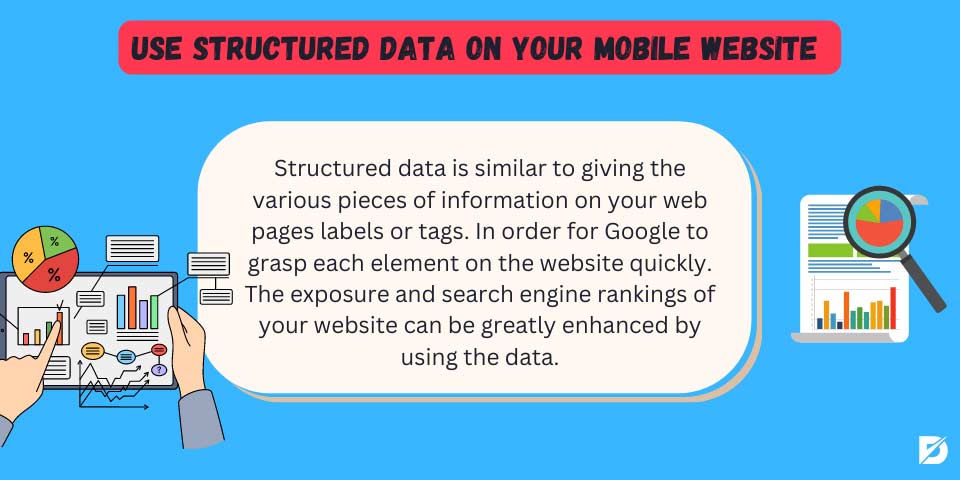
Use Structured Data on Your Mobile Website
Before discussing this tip, we should first understand the structured data meaning. Structured data, also known as schema markup, provides Google with additional information about your website’s content. In other words, this type of data helps Google to understand your content easily. In simpler terms, structured data is like adding labels or tags to the different pieces of information on your web pages. So Google can easily understand what each element on the page is. When you use the data, you can significantly improve your website’s visibility and search engine rankings. You should use a structured data testing tool to be sure.
Suppose you have an article about a recipe on your web pages. The structured data for this page includes the details of the recipe article, such as the recipe name, ingredients, and cooking times. When Google visits that web page to index and rank it, they use this data to be knowledgeable about your content.
Of course, there are more reasons why using structured data on your website is essential other than providing additional information. This data also helps Google and other search engines present your content more accurately. In return, they can better understand the relevance of search results for users. So, your rankings will be even better when users find the information they need quickly and easily. Structured data also helps Google understand your mobile content better. That’s because Google and others use mobile-first indexing by prioritizing the mobile version of websites when crawling, indexing, and ranking. Moreover, structured data can help with local SEO efforts for businesses. It lets you provide location-specific information, such as your business’s name, address, phone number, and opening hours. So your potential visitors will be able to find you and your shop on their mobile devices easily. Create structured data with a schema markup generator!
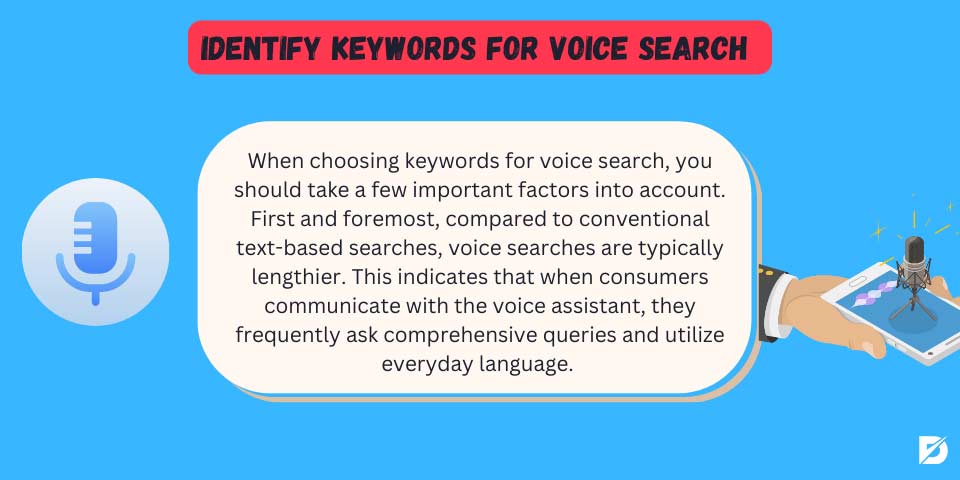
Identify Keywords for Voice Search
As we all know, voice search has gained incredible popularity thanks to the virtual assistance of the world’s biggest brands. Apple’s Siri or Google Assistant pushes you to optimize your content for your search behaviors. At this point, you should consider some key points while identifying keywords for voice search. First and foremost, voice searches are generally longer compared to traditional text-based searches. This means that users have a tendency to ask complete questions and use daily language when speaking to the voice assistant. Finding the exact questions people ask when using voice commands helps you make your content match how people actually search.
Besides, mobile users often turn to voice commands when multitasking or driving. That’s why they expect fast answers as much as possible. Therefore, you need to optimize your content for voice search to make it accessible and relevant to users’ needs. At this point, voice search often uses information from quick answers. So, You can achieve this by identifying keywords that trigger these types of search results. So you can increase your chances of being selected as the source of information in voice search responses.
You might face some challenges while identifying keywords for voice search. However, there are easy ways to achieve this. You can start by considering the questions mobile users might ask when searching for a specific thing. Think about the questions customers might ask when searching for a bakery. The keywords those customers could use include queries about types of bread, opening hours, location, and more. Besides, instead of just using short keywords, you can focus on phrases that customers might naturally say when asking a question. To give an example, “Best breakfast place near me” or “What is the opening hour of x bakery.”
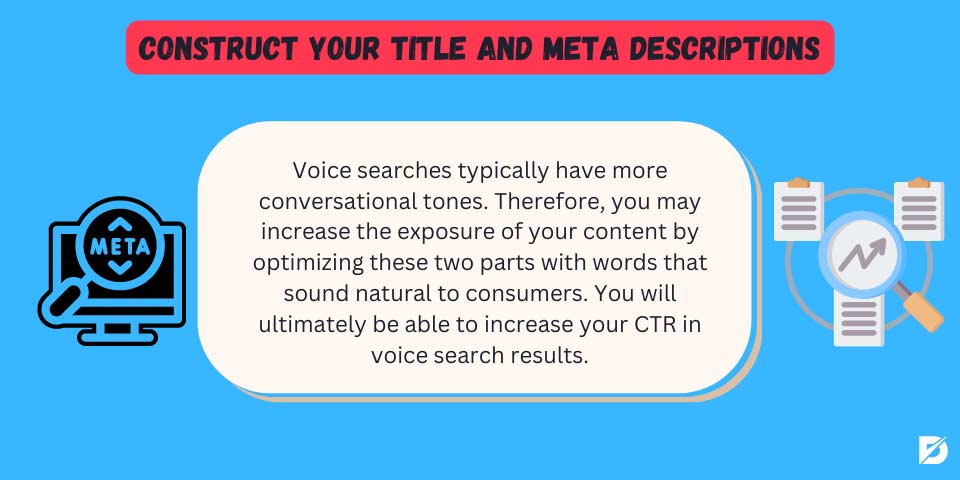
Construct Your Title and Meta Descriptions Toward Mobile Search Results
In order to access the internet, usage of mobile phones has been incredibly increasing. That’s why adapting your web page content title and meta descriptions is very important for mobile SEO. You might be asking, “Why should I do this?” there are a lot of answers to your question.
We easily recognize that mobile device screens have limited space to display search results. That’s why using short but effective title tags and meta descriptions is essential. So your content is effectively communicated within the limited screen. Besides, mobile users typically try to find quick answers to their needs. You can increase click-through rates once you create mobile-specific title tags and meta descriptions that address users’ needs directly.
Moreover, voice search queries are generally more natural in tone. Therefore, optimizing these two elements with phrases that match how people speak allows you to improve your content’s visibility. At the end of the day, you will be able to get more CTR in voice search results. Finally, providing accurate and relevant information in your title and meta descriptions helps you to offer clear expectations. So users will be able to know exactly what they are going to see once they click on your website. This will help you reduce bounce rates in your mobile SEO strategy.
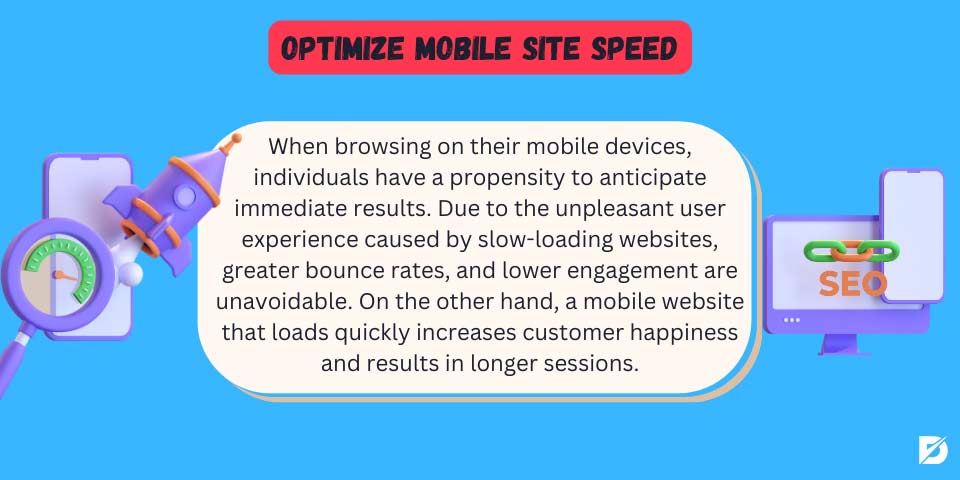
Optimize Mobile Site Speed
There are dozens of reasons why focus on mobile site speed. First and foremost, people have a tendency to expect quick and fast results while browsing on their mobile devices. Therefore, slow-loading websites have a negative impact on users, so higher bounce rates and lower engagement become inevitable. On the other side, a fast-loading mobile website improves user satisfaction and creates longer sessions. Besides, Google and other search engines consider page speed a significant ranking factor, especially on mobile phones. Once you obtain a faster-loading website, you will be able to rank higher in search results. So, do a website speed test and use a rank checker to keep track.
Search engines, especially Google, primarily index the mobile version of a website in the desktop and mobile SEO world. Therefore, if your mobile site is slow to load, it might negatively impact your website’s crawling, indexing, and ranking. At this point, have you ever heard of abandonment rates? This is what mobile users leave your website before it fully loads. Thus, if you don’t speed up your page loading, it will lead to higher abandonment rates, resulting in losing visitors. On the other side, faster mobile websites create higher conversion rates. Why? That’s because improved website speed allows mobile users to quickly sign up, purchase, and take other desired actions.
Furthermore, in order to speed up your website loading time, you need to apply mobile-friendly design practices perfectly. For example, you need to have a responsive design, minimizing codes and compressed images in your mobile SEO strategy. All these create a better mobile user experience. Finally, not all mobile users browse situations where internet conditions are perfect. Therefore, optimizing your website speed allows you to make sure that your website content is accessible even under such circumstances.
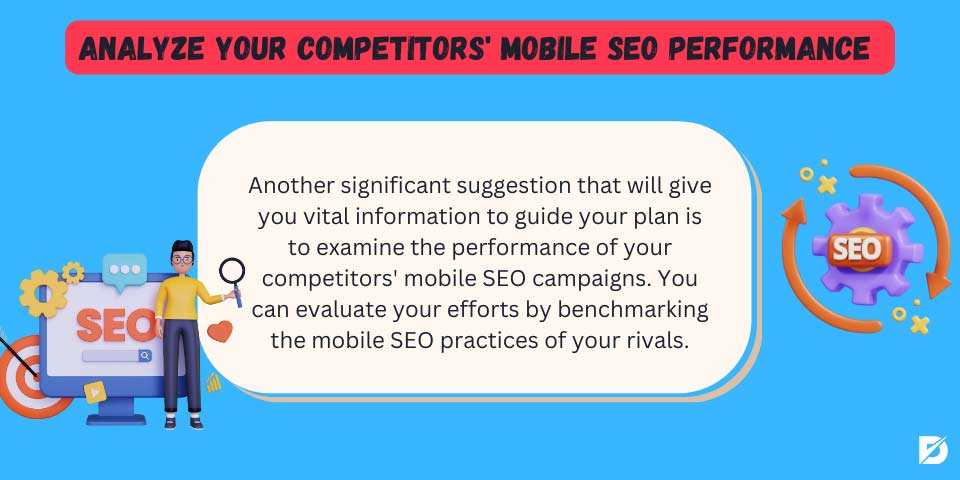
Analyze Your Competitors’ Mobile SEO Performance
Analyzing your competitors’ mobile SEO performance is another essential tip that provides crucial insights to inform your strategy. Understanding your competitors’ behaviors in mobile SEO lets you benchmark your efforts. When you compare their performance to yours, you can easily and firstly detect gaps for improvement in your strategy. Besides, you can stay updated on industry trends once you analyze your competitors’ mobile SEO practices perfectly. So, this knowledge enables you to adapt your strategies to remain competitive. Moreover, examining your competitors’ mobile strategy helps you find keywords they aren’t targeting and content gaps they haven’t filled. All these let you improve your mobile site content.
When you do a competitor analysis, you can learn from their mistakes, which might be your mistakes in the future. So you can have a chance to avoid pitfalls in your mobile SEO strategy before you do it. In other words, identifying your competitors’ weaknesses helps you strengthen your strategy. Once you achieve this, you can save time and concentrate on other essential things. Finally, learning from your competitors is key to discovering unique mobile SEO techniques to differentiate your SEO strategies for mobile devices from others.
To conduct competitor analysis in mobile SEO, you can use many mobile SEO agencies. For example, SEMrush, Ahrefs, and Google’s Keyword Planner enable you to research the keywords your competitors are targeting for mobile search. Besides, these tools examine the type of content your competitors are creating for people. You can also use other mobile SEO companies like Google PageSpeed Insights or Gtmetrix. So you can understand the performance of your competitors’ website page speed. Don’t forget to take a look at the useful competitor analysis tools you can use for your strategies.
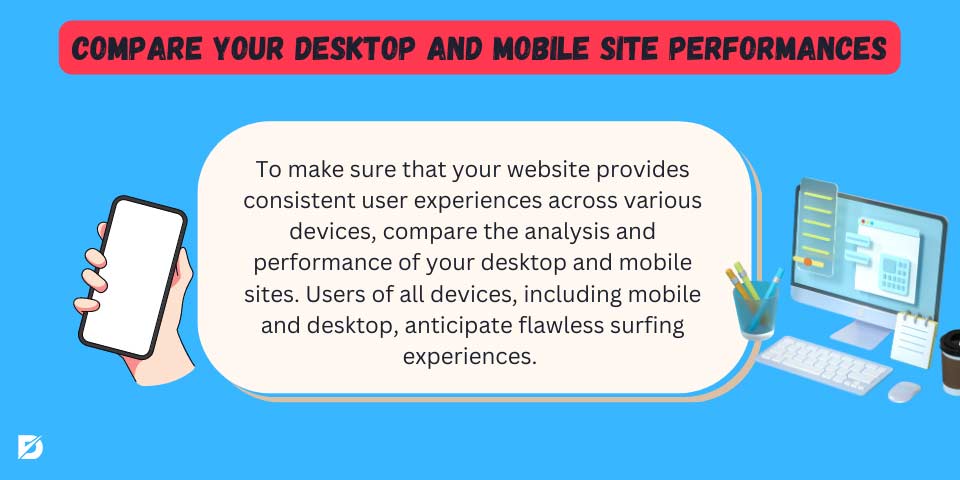
Compare Your Desktop and Mobile Site Performances
Comparing your desktop and mobile site analysis and performance helps ensure that your website offers consistent user experiences on different devices. That’s because mobile and desktop users expect seamless browsing experiences regardless of their preferred devices. Comparing your website’s performance helps you detect discrepancies. So you can ensure that users have a consistent and user-friendly experience on mobile and desktop devices.
Comparing your website’s performance on both desktop and mobile devices, you can detect issues that are unique to mobile devices. For example, you can quickly and quickly determine whether your website has slow loading times or broken links. When you solve these problems on the mobile version of your website, you will have a chance to improve mobile user experiences. As we know, Google and other search engines firstly index mobile versions of a website. Therefore, if you compare your performances, you can ensure your mobile site is well-optimized for crawling, indexing, and rankings.
Comparing your desktop and mobile site performance also enables you to uncover user behavior differences. When you gain this insight with mobile SEO, you can adapt your website’s mobile version for higher conversion rates.
Finally, making comparisons accelerates the improvement of the entire process. Elements that might be lacking on a mobile site but present on a desktop are quickly identified, or vice versa. All these create a better user experience by meeting their expectations at the end of the day.
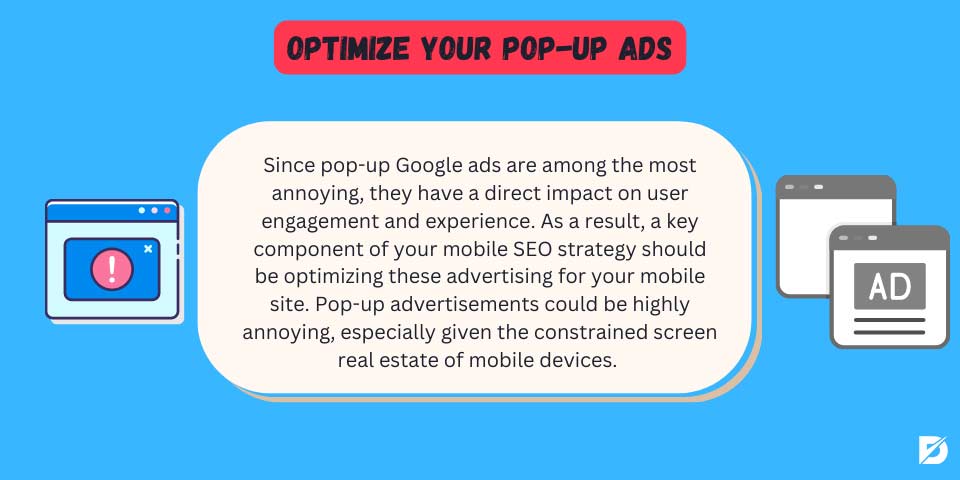
Optimize Your Pop-up Ads
Since pop-up Google ads are one of the most frustrating, they directly affect user experience and engagement. Therefore, optimizing these ads for your mobile site is vital to your mobile SEO strategy. Pop-up ads might be very disruptive, especially considering the limited screen space of mobile devices. However, optimizing these ads helps you ensure users can smoothly access and interact with your content. So, how are you going to achieve this? Optimized pop-ups have appropriately sized elements. These elements can be in the form of close buttons or responsive layouts that perfectly fit the different screen sizes. All these help you ensure they don’t hinder the usability of your mobile site.
On the other side, if you don’t optimize your pop-up ads for mobile devices, you might have a higher bounce rate. That’s because users leave your site immediately if they are bombarded with ads and visit your best competitors’ sites.
Most search engines, especially Google, penalize websites with frustrating pop-ups that hinder user access to content in the mobile SEO world. These ads prevent user satisfaction and lead to a negative user experience. So it’s important to follow search engines’ guidelines for mobile pop-ups to stay competitive in SERPs. Finally, for business owners with physical locations, well-optimized pop-ads adc provide valuable and helpful information without hindering user experience.
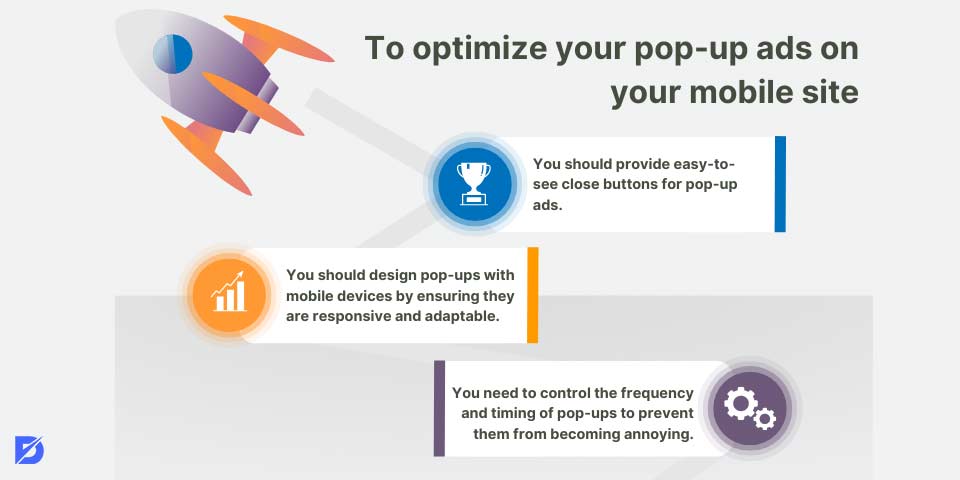
To optimize your pop-up ads on your mobile site, there are several tips you should care about:
- You need to control the frequency and timing of pop-ups to prevent them from becoming annoying.
- You should design pop-ups with mobile devices by ensuring they are responsive and adaptable for different screen sizes. At this point, avoid large pop-ups covering the entire mobile phone screen, for example.
- You should provide easy-to-see close buttons for pop-up ads.
So mobile users should be able to dismiss the pop-up easily and quickly if they’re not interested.
Monitoring Mobile SEO Success
You implemented every step into your website, but it is not over yet. Even if you manage to attract more mobile users to your website, there is no telling the fact that your website will maintain its success forever. Let’s look at the key methods to monitor your website in terms of mobile SEO:
- Traffic: Detecting the traffic that occurs from mobile devices is the common way to monitor your website. One of Google’s free analytic tools or Dopinger’s rank checker can help you with that.
- Mobile SERP Rankings: It is important for you to check your website’s rankings through mobile search engine results.
- Click-Through Rate (CTR): Determine the most popular listings and contents that your mobile users are clicking on and optimize your website based on the CTR of your search listings.
The Future Importance of Mobile SEO and Voice Search
There is only one particular fact regarding the future of mobile SEO and voice search. Their importance will become more super important. Since consumer behavior is shifting each day, these two digital elements have become increasingly important. We would like to look at the future importance of mobile SEO and voice search separately. Let’s first look at mobile SEO.
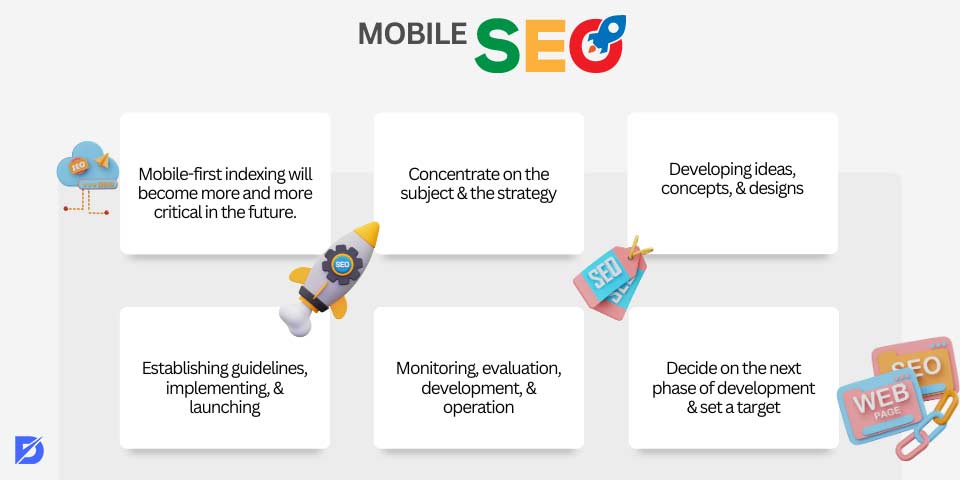
Mobile SEO
Most people use their mobile phones more than their desktop computers to search for stuff on the web. Therefore, mobile SEO will become even more important for website owners in the near future. At this point, there are some predictions of mobile SEO. Here are some key ones.
- Mobile-first indexing will become more and more critical in the future. Therefore, making your website work well on mobiles ensures it can compete when people search on their phones.
- The importance of mobile-friendly website designs will continue to be popular. You level the playing field with your competitors when you make a website that works well on phones.
- The desire to access information fastest is growing day by day. Thus, slow, loading websites can be only a cost in front of traffic and conversions.
- As apps continue to be popular, optimizing them for better visibility within mobile app stores will be a part of mobile SEO.
- Artificial intelligence and machine learning are essential with each passing day. So, understanding user behavior and providing personalized mobile experiences will become easier.
- Every day, new mobile technology is emerging. While mobile devices are currently limited to smartphones and watches, a wide range of technologies awaits us soon. Therefore, mobile SEO is crucial for adapting to new devices and different screen sizes and accommodating changing search behaviors.

Voice Search
We all live in a fast-paced era, so we want to access information as quickly as possible without much effort. This is where voice search comes into play. Voice searches are already heavily used, especially when performing multiple tasks. Let’s say a driver wants to find the nearest bakery while driving. The first thing that comes to their mind is to use voice search. We will likely see an increase in such examples shortly.
- Voice-activated assistants will become more popular. As more people use voice-activated devices, understanding and optimizing for these queries becomes crucial.
- As mentioned above, mobile users tend to ask questions using natural language rather than typing keywords. Therefore, we will see websites offering content to match these spoken queries.
- Voice search frequently involves location-based queries like “near me” searches. In the future, optimizing your mobile site for local SEO to attract nearby customers will become more critical.
- Voice search has a chance to become even more integrated into daily life, extending beyond mobile phones. For example, we can even now see that voice search is integrated into high-quality cars, appliances, and wearables.
- Every day, artificial intelligence is reducing language barriers. At this point, voice searches allow us to further eliminate these barriers. They can search in their native languages when mobile sites are optimized for multilingual voice search.
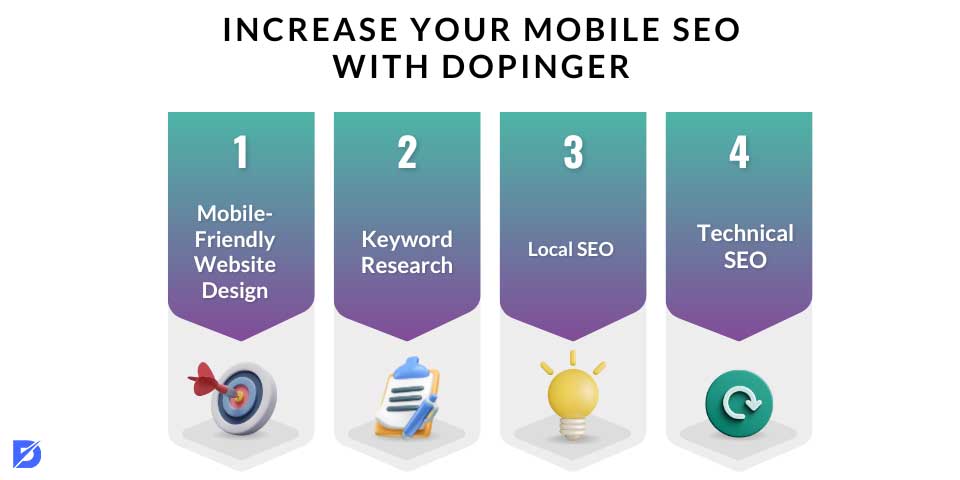
Increase Your Mobile SEO with Dopinger
In addition to the SEO service of the site named Dopinger, it also provides services for mobile SEO.
Let’s look at these services:
- Mobile-Friendly Website Design: One of the pillarstones of your website is being responsive. Responsive means that your website design should get used to different types of screen sizes and adjust itself according to these changes.
- Keyword Research: Targeting keywords for your mobile website is essential for the rankings if you want to increase your website’s discoverability.
- Local SEO: Dopinger can support you with a local SEO method that aims to assist your physical location in terms of SEO assistance.
- Technical SEO: Technical SEO includes structured data and XML sitemaps. Optimizing these two is a must if you want to see your website in the top rankings.
Conclusion
Today, we tried to provide everything in our comprehensive guide. After discussing mobile SEO in detail, we introduced its elements, from responsive design to a touch-friendly interface. Then, we tried to answer the “Why is mobile SEO Important?” and listed various reasons. After that, we mentioned four things you need to know about mobile-first indexing: Creating mobile-friendly content and a responsive web design, doing a mobile-friendliness test, and improving your website speed. Mobile-first indexing is crucial since Google and other search engines prioritize mobile experience for their users. Therefore, we wanted to list three key elements of a mobile-friendly website. These are responsive design, dynamic serving, and separate URLs.
After learning all the fundamentals of mobile SEO, we touched on a fundamental question: How will you check whether your website is optimized for mobile devices? At this point, we preferred to introduce Google’s most used mobile SEO services: Google Search Console, Mobile-Friendly Test Tool, and PageSpeed Insights. After examining all the easy steps to use these three tools, we briefly examine the differences between desktop and mobile SEO. At this stage, the most significant differences come from the user behaviors on mobile phones’ small and large desktop screens. Then, we wanted to give simple but effective SEO tips, from creating your content as mobile-friendly to optimizing your pop-up ads. Finally, we simply mentioned the future importance of mobile SEO and voice search. We hope you find everything you need in your mobile SEO rankings and processes.
Frequently Asked Questions About
Mobile SEO refers to optimizing websites and their pages to improve their visibility and performance on mobile devices. This term has become essential in ensuring that websites are effectively accessible and usable on mobile devices.
Mobile-first indexing means search engines prioritize a website’s mobile version for indexing and rankings in search results. This term is one of the essential approaches considered by Google to have higher rankings on SERPs.
There are a range of things to perform mobile SEO. As mentioned above, some are mobile-friendly design, page speed optimization, touch-friendly interface, and mobile-optimized content.
A mobile-friendly website is a website that is designed and optimized to provide a smooth experience for users. So they can quickly and fastly access any information on mobile devices, from mobile phones to tablets. It features responsive design elements that adapt to different screen sizes, ensuring easy-to-read content and buttons are easy to tap.
The most significant difference between these two strategies is that mobile SEO focuses on a smooth user experience on small screens. It concentrates on mobile-friendliness, easy-to-touch elements, and higher page speed. Conversely, desktop SEO centers focus on content depth for larger screens.
Mobile site speed is vital for SEO as it directly impacts user experience and search engine rankings. Fast-loading websites increase user satisfaction and reduce bounce and abandonment rates. When users stay longer on a mobile site, that website can get more organic traffic.
Responsive design can be defined as a website layout that automatically adapts its design to different screen sizes. So it doesn’t matter the device a user uses; that user will see a consistent layout and design.
Achieving this is easier than you think. The world’s biggest search engine, Google’s Mobile-Friendly Test tool, analyzes your website and provides feedback on its mobile-friendliness. You can also use Google Search Console to get a Mobile Usability report highlighting any mobile issues Google detects.
With voice assistants on mobile phones, users’ searches have a tendency to be more natural and search for question-based information. That’s why optimizing your mobile site for voice search can be achieved by providing quick answers and targeting long-tail keywords.





No comments to show.